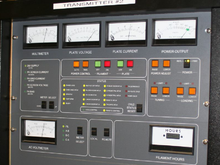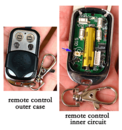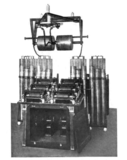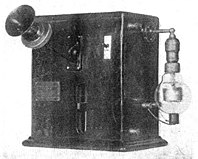Transmitter

Commercial FM broadcastingtransmitter at radio station WDET-FM, Wayne State University, Detroit, USA. It broadcasts at 101.9 MHz with a radiated power of 48 kW.

A radio transmitter is usually part of aradio communication system which uses electromagnetic waves (radio waves) to transport information (in this case sound) over a distance.
In electronics and telecommunications atransmitter or radio transmitter is anelectronic device which produces radio waveswith an antenna. The transmitter itself generates a radio frequency alternating current, which is applied to the antenna. When excited by this alternating current the antenna radiates radio waves.
Transmitters are necessary component parts of all electronic devices that communicate byradio, such as radio and televisionbroadcasting stations, cell phones, walkie-talkies, wireless computer networks,Bluetooth enabled devices, garage door openers, two-way radios in aircraft, ships, spacecraft, radar sets and navigational beacons. The term transmitter is usually limited to equipment that generates radio waves for communication purposes; orradiolocation, such as radar and navigational transmitters. Generators of radio waves for heating or industrial purposes, such asmicrowave ovens or diathermy equipment, are not usually called transmitters even though they often have similar circuits.
The term is popularly used more specifically to refer to a broadcast transmitter, a transmitter used in broadcasting, as in FM radio transmitter or television transmitter. This usage typically includes both the transmitter proper, the antenna, and often the building it is housed in.
An unrelated use of the term is in industrialprocess control, where a "transmitter" is atelemetry device which converts measurements from a sensor into a signal, and sends it, usually via wires, to be received by some display or control device located a distance away.
Description
A transmitter can be a separate piece of electronic equipment, or an electrical circuit within another electronic device. A transmitter and a receiver combined in one unit is called atransceiver. The term transmitter is often abbreviated "XMTR" or "TX" in technical documents. The purpose of most transmitters is radio communication of information over a distance. The information is provided to the transmitter in the form of an electronic signal, such as an audio (sound) signal from a microphone, a video (TV) signal from a video camera, or in wireless networking devices adigital signal from a computer. The transmitter combines the information signal to be carried with the radio frequency signal which generates the radio waves, which is called the carrier signal. This process is calledmodulation. The information can be added to the carrier in several different ways, in different types of transmitters. In anamplitude modulation (AM) transmitter, the information is added to the radio signal by varying its amplitude. In a frequency modulation (FM) transmitter, it is added by varying the radio signal's frequency slightly. Many other types of modulation are used.
The radio signal from the transmitter is applied to the antenna, which radiates the energy as radio waves. The antenna may be enclosed inside the case or attached to the outside of the transmitter, as in portable devices such as cell phones, walkie-talkies, and garage door openers. In more powerful transmitters, the antenna may be located on top of a building or on a separate tower, and connected to the transmitter by a feed line, that is a transmission line.
Radio transmitters
35 kW, Continental 816R-5B FM transmitter, belonging to American FM radio station KWNR broadcasting on 95.5 MHz in Las Vegas
Modern amateur radio transceiver, the ICOM IC-746PRO. It can transmit on the amateur bands from 1.8 MHz to 144 MHz with an output power of 100 W
A CB radio transceiver, a two way radio transmitting on 27 MHz with a power of 4 W, that can be operated without a license
Consumer products that contain transmitters
Both the handset and the base of acordless phonecontain low power 2.4 GHz radio transmitters to communicate with each other.
A garage door opener control contains a low-power 2.4 GHz transmitter that sends coded commands to the garage door mechanism to open or close.
An RFID chip (next to rice grain) contains a tiny transmitter that transmits an identification number. They are incorporated into consumer products, and even implanted in pets.
In a wireless computer network, wireless routerslike this contain a 2.4 GHz transmitter that sends web pages and email to local computers.
History
The first primitive radio transmitters (called Hertzian oscillators) were built by German physicist Heinrich Hertz in 1887 during his pioneering investigations of radio waves. These generated radio waves by a high voltage spark between two conductors. Beginning in 1895 Guglielmo Marconideveloped the first practical radio communication systems using spark transmitters. They couldn't transmit audio(sound) and instead transmitted information by telegraphy, the operator tapping on atelegraph key which turned the transmitter on and off to produce pulses of radio waves spelling out text messages in Morse code. These spark-gap transmitters were used during the first three decades of radio (1887-1917), called the wireless telegraphy or "spark" era. Because they generated damped waves, spark transmitters were electrically "noisy"; their energy was spread over a broad band of frequencies, creating radio noisewhich interfered with other transmitters. Two short-lived competing transmitter technologies came into use after the turn of the century, which were the first continuous wave transmitters: the Alexanderson alternator and Poulsen arc transmitters, which were used into the 1920s.
All these early technologies were replaced byvacuum tube transmitters in the 1920s, which used the feedback oscillator invented byEdwin Armstrong and Alexander Meissneraround 1912, based on the Audion (triode) vacuum tube invented by Lee De Forest in 1906. Vacuum tube transmitters took over because they were inexpensive and producedcontinuous waves, which could be modulatedto transmit audio (sound) using amplitude modulation (AM). This made possible AMradio broadcasting, which began in about 1920. Practical frequency modulation (FM) transmission was invented by Edwin Armstrong in 1933, who showed that it was less vulnerable to noise and static than AM, and the first FM radio station was licensed in 1937. Experimental television transmission had been conducted by radio stations since the late 1920s, but practical television broadcasting didn't begin until the 1930s. The development of radar during World War II was a great stimulus to the evolution of high frequency transmitters in the UHF andmicrowave ranges, using new devices such as the magnetron, klystron, and traveling wave tube.
The invention of the transistor allowed the development in the 1960s of small portable transmitters such as wireless microphonesand walkie-talkies, although the first walkie-talkie was actually produced for the military during World War II using vacuum tubes. The development of the integrated circuit (IC) in the 1970s made possible the current proliferation of wireless devices, in which integrated digital transmitters operate automatically, in the background, to exchange data with wireless networks. In recent years, the need to conserve crowded radio spectrumbandwidth has driven the development of new types of transmitters such as spread spectrum.
Guglielmo Marconi's spark gap transmitter, with which he performed the first experiments in practical radio communication in 1895-1897
1 MW US Navy Poulsen arc transmitter which generated continuous waves using an electric arc in a magnetic field, a technology used from 1903 until the 1920s
An Alexanderson alternator, a huge rotating machine used as a radio transmitter for a short period from about 1910 until vacuum tube transmitters took over in the 1920s
One of the first vacuum tube AMradio transmitters, built by Lee De Forest in 1914. The early Audion(triode) tube is visible at right.
How it works
A radio transmitter is an electronic circuitwhich transforms electric power from a battery or electrical mains into a radio frequency alternating current, which reverses direction millions to billions of times per second. The energy in such a rapidly reversing current can radiate off a conductor (the antenna) as electromagnetic waves (radio waves). The transmitter also impresses information such as an audio or video signal onto the radio frequency current to be carried by the radio waves. When they strike the antenna of a radio receiver, the waves excite similar (but less powerful) radio frequency currents in it. The radio receiver extracts the information from the received waves. A practical radio transmitter usually consists of these parts:
- A power supply circuit to transform the input electrical power to the higher voltagesneeded to produce the required power output.
- An electronic oscillator circuit to generate the radio frequency signal. This usually generates a sine wave of constantamplitude often called the carrier wave, because it serves to "carry" the information through space. In most modern transmitters this is a crystal oscillator in which the frequency is precisely controlled by the vibrations of a quartz crystal.
- A modulator circuit to add the information to be transmitted to the carrier wave produced by the oscillator. This is done by varying some aspect of the carrier wave. The information is provided to the transmitter either in the form of an audio signal, which represents sound, a video signal, or for data in the form of a binarydigital signal.
- In an AM (amplitude modulation) transmitter the amplitude (strength) of the carrier wave is varied in proportion to the modulation signal.
- In an FM (frequency modulation) transmitter the frequency of the carrier is varied by the modulation signal.
- In an FSK (frequency-shift keying) transmitter, which transmits digital data, the frequency of the carrier is shifted between two frequencies which represent the two binary digits, 0 and 1.
- Many other types of modulation are also used. In large transmitters the oscillator and modulator together are often referred to as the exciter.
- An RF amplifier to increase the power of the signal, to increase the range of the radio waves.
- An impedance matching (antenna tuner) circuit to match the impedance of the transmitter to the impedance of the antenna (or the transmission line to the antenna), to transfer power efficiently to the antenna. If these impedances are not equal, it causes a condition called standing waves, in which the power is reflected back from the antenna toward the transmitter, wasting power and sometimes overheating the transmitter.
In higher frequency transmitters, in the UHFand microwave range, free running oscillators are unstable at the output frequency. Older designs used an oscillator at a lower frequency, which was multiplied by frequency multipliers to get a signal at the desired frequency. Modern designs more commonly use an oscillator at the operating frequency which is stabilized by phase locking to a very stable lower frequency reference, usually a crystal oscillator.
Legal restrictions
In most parts of the world, use of transmitters is strictly controlled by law because of the potential for dangerous interference with other radio transmissions (for example to emergency communications). Transmitters must be licensed by governments, under a variety of license classes depending on use such as broadcast, marine radio, Airband,Amateur and are restricted to certain frequencies and power levels. A body called the International Telecommunications Union(ITU) allocates the frequency bands in theradio spectrum to various classes of users. In some classes each transmitter is given a unique call sign consisting of a string of letters and numbers which must be used as an identifier in transmissions. The operator of the transmitter usually must hold a government license, such as a general radiotelephone operator license, which is obtained by passing a test demonstrating adequate technical and legal knowledge of safe radio operation.
An exception is made allowing the unlicensed use of low-power short-range transmitters in devices such as cell phones, cordless telephones, wireless microphones, walkie-talkies, Wifi and Bluetooth devices, garage door openers, and baby monitors. In the US, these fall under Part 15 of the Federal Communications Commission (FCC) regulations. Although they can be operated without a license, these devices still generally must be type-approved before sale.












Comments
Post a Comment